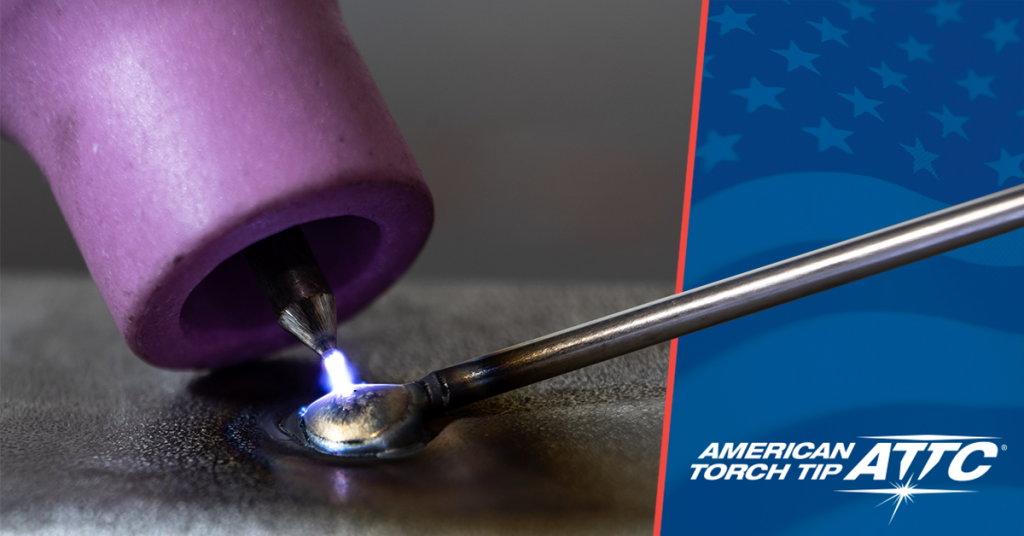

When choosing the right TIG filler metal, you will find a wide variety of products on the market. From steel, and aluminum, to an assortment of tungsten, there are many fillers to choose from. Each one has different benefits, so scope out the project at hand and make sure any filler you use is up to the task. You want to be sure to read any and all rod specifications before striking an arc.
Tungsten Electrodes
Technically speaking, the tungsten electrodes used in welding are not meant to serve as filler rod. Tungsten is hardy and has high heat resistance, with the highest melting point of any metal (3,410°C/6,170°F). You can purchase tungsten electrodes in several quantities, but they typically come in 10pc packs. They have varied diameters and come in seven or three-inch lengths, and which one you need depends on what standard tip came with your TIG torch. You can purchase electrodes composed of either pure tungsten or a hybrid of tungsten and other rare elements, oxides, and alloys, and the electrodes are color-coded at their tips for ease of identification. Your choice of electrode is also dependent on your base material, its thickness, and whether you weld with a direct or alternating current.
Pure Tungsten Electrodes (EWP; ISO = W) Color-Coded Green
Made from 99.50% tungsten, this is a cost-effective option, yet, it has the highest consumption rate. Pure tungsten is routinely used for AC welding of aluminum and magnesium at low currents and forms a clean, balled tip when heated. These electrodes are good for arc stability for AC welding. It is not usually used for DC welding, simply because it does not provide a strong arc start typically associated with other hybrids, such as thoriated or ceriated electrodes.

Thoriated Tungsten Electrodes (EWTh-2; ISO = WT20) Color-Coded Red
Expensive and radioactive, these rods have a minimum of 97.30% tungsten and 1.70-2.20% thorium and are sometimes called 2% Thoriated. You should wear a dust mask when grinding, and make sure to keep skin covered and avoid contact with the metal when heated. Thoriated electrodes are most commonly used in America, and are popular for their stability, longevity, and ease-of-use. Thoriated electrodes are mainly used for DC welding (on carbon and stainless steels, nickel, and titanium) as well as specialty AC welding, as they are ideal for thin aluminum (or materials less than 0.060” thick).
Ceriated Tungsten Electrodes (EWTh-2; ISO = WC20) Color-Coded Orange
With a minimum of 97.30% tungsten and 1.80-2.20% cerium, these non-radioactive rods are sometimes called 2% Ceriated. These electrodes are a good substitute for thoriated tungsten. They can achieve high currents and have good arc stability, and they work best in DC welding at low current settings but are versatile. Ceriated tungsten is popular in orbital tube and pipe manufacturing, thin sheet metal work, or projects with intricate parts. Like thoriated, ceriated works best when welding carbon and stainless steels, nickel, and titanium. We do not recommend using ceriated tungsten at higher amperage.
Looking for a free, quick-reference TIG troubleshooting list? Download it here.
Lanthanated Tungsten Electrodes (EWIa-1.5; ISO = WL15) Color-Coded Gold
These have a minimum of 97.80% tungsten and 1.30-1.70% lanthanum, or lanthana, and are also known as 1.5% Lanthanated. These electrodes have outstanding arc starting, a low-burn-off rate, great arc stability, and has excellent re-ignition characteristics, very much like ceriated tungsten, and are ideal to optimize your welding. These electrodes also have similar conductivity to thoriated tungsten, and in some cases, you can use these rods to replace thoriated tungsten without having to make program changes. It is also a safer, and cheaper, substitute for thoriated tungsten. These electrodes can be used for steel and stainless steel at a wide range of currents.
Zirconiated Tungsten Electrodes (EWZr-2; ISO = WZ3) Color-coded Brown
With a minimum of 99.10% tungsten and 0.15-0.40% zirconium, they produce an exceedingly stable arc that resists tungsten splitting. They are ideal for AC welding by retaining a balled tip and boast a high resistance to contamination. It is similar to thoriated tungsten in its conductivity. From a performance standpoint, it is the worst non-radioactive tungsten. For DC welding, we do not recommend zirconiated tungsten.
TIG Filler Rods
Different from tungsten electrodes in that they must be fed manually into the molten puddle by hand. The TIG filler rod must correctly match the material to weld, and the thickness of the material will determine the diameter of the rod. Most TIG rods are mild steel, stainless steel, nickel, aluminum, etc. When bonding like materials, it is always correct to use a rod of the same metal to bond.
For example, if you were trying to weld aluminum to aluminum, you would use an aluminum rod. For repairs, specialized projects, and patch jobs, you may have to select a rod that is different from one or both of the base materials. You can use a nickel rod, for example, to weld steel and cast iron. Some other examples include carbon steel rods that are commonly used for small tubing/pipes and sheet metal. Stainless steel rods are popular for their high rust and corrosion resistance in manufacturing.
Choose American Torch Tip For Your Tig Filler Needs
When choosing your TIG filler metal, it is always important to take your base metal, and its joint type, thickness, and thermal properties into account, as well as the current you’ll be using. There are many helpful charts online detailing different alloys and metals with which filler rod to use.
For troubleshooting assistance with TIG, download this free handy checklist!
American Torch Tip specializes in TIG welding parts and processes. Plus, you can read our blog for more resources. If you’re looking to get in touch with us, call (941) 753-7557.
Sign up for our Monthly Newsletter
Join our community of over 20,000 industry experts and subscribe to our newsletters to receive product announcements and offers.